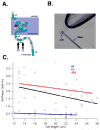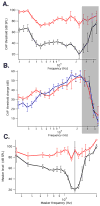Prestin-based outer hair cell motility is necessary for mammalian cochlear amplification
- PMID: 18466744
- PMCID: PMC2435065
- DOI: 10.1016/j.neuron.2008.02.028
Prestin-based outer hair cell motility is necessary for mammalian cochlear amplification
Abstract
It is a central tenet of cochlear neurobiology that mammalian ears rely on a local, mechanical amplification process for their high sensitivity and sharp frequency selectivity. While it is generally agreed that outer hair cells provide the amplification, two mechanisms have been proposed: stereociliary motility and somatic motility. The latter is driven by the motor protein prestin. Electrophysiological phenotyping of a prestin knockout mouse intimated that somatic motility is the amplifier. However, outer hair cells of knockout mice have significantly altered mechanical properties, making this mouse model unsatisfactory. Here, we study a mouse model without alteration to outer hair cell and organ of Corti mechanics or to mechanoelectric transduction, but with diminished prestin function. These animals have knockout-like behavior, demonstrating that prestin-based electromotility is required for cochlear amplification.
Figures




Comment in
-
Silencing the cochlear amplifier by immobilizing prestin.Neuron. 2008 May 8;58(3):299-301. doi: 10.1016/j.neuron.2008.04.018. Neuron. 2008. PMID: 18466739 Free PMC article. Review.
References
-
- Ashmore JF. Forward and reverse transduction in the mammalian cochlea. Neurosci Res Suppl. 1990;12:S39–S50. - PubMed
-
- Brownell W, Bader CR, Bertrand D, de Ribaupierre Y. Evoked mechanical responses of isolated cochlear outer hair cells. Science. 1985;227:194–196. - PubMed
-
- Cheatham MA, Dallos P. Longitudinal comparisons of IHC AC and DC receptor potentials recorded from the guinea-pig cochlea. Hear Res. 1993;68:107–114. - PubMed
Publication types
MeSH terms
Substances
Grants and funding
- R01 DC006471/DC/NIDCD NIH HHS/United States
- DC00089/DC/NIDCD NIH HHS/United States
- R01 DC004696/DC/NIDCD NIH HHS/United States
- CA21765/CA/NCI NIH HHS/United States
- DC006412/DC/NIDCD NIH HHS/United States
- DC 004696/DC/NIDCD NIH HHS/United States
- CA023944/CA/NCI NIH HHS/United States
- R25 CA023944/CA/NCI NIH HHS/United States
- DC06471/DC/NIDCD NIH HHS/United States
- R01 DC006412/DC/NIDCD NIH HHS/United States
- UL1 RR025741/RR/NCRR NIH HHS/United States
- P30 CA021765/CA/NCI NIH HHS/United States
- R01 DC000089/DC/NIDCD NIH HHS/United States
LinkOut - more resources
Full Text Sources
Other Literature Sources
Molecular Biology Databases

